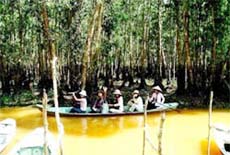One of the many reasons I love Vietnam is the motorbike culture. Give me a motorbike over a car any day. Ask anyone that’s read Zen and the Art of Motorcycle Maintenance and they’ll tell you, it’s the simple joy of traveling without viewing the scenery through a windscreen that makes motorcycling anywhere fantastic. But when the scenery is as good as deep in the Mekong Delta the experience is epic.
 |
| Tourists on board one of the skiffs at Xeo Quyt after being taken around the narrow canals |
The road to Dong Thap Province is fairly wide and in good condition. Once out of the tangled tapestry of the Saigon traffic and the industrial satellite towns, the road opens up and you can afford to glance more than momentarily at the world going past. But it’s still extremely random out there so don’t get too relaxed.
But still the highway is the highway and it presents a fairly homogenous culture anywhere you go with limited offerings of coffee, coke and soups. So I decided to dive down some narrow tracks whenever I needed some food, drink or time to refresh. The results were heart warming. Less than 50 meters off the noisy arteries of this country, life goes on as though the locals don’t know that trucks and buses and foreigners exist.
One such place was a hut in the fields that specialized in selling wine and grilled rats. While at first skeptical I was soon sold on the tasty little creatures that were no doubt fresh from the back door.
 |
| The house in Sa Dec where French author Marguerite Duras lived between 1928 and 1932 and the scene of her famous book “The Loversâ€. It used to be used by government but is now open to tourists |
Dong Thap is divided by a river. On one side is Sa Dec, a historic little town that would do well to convert some of its French colonial buildings into comfortable guesthouses. While the limited range of hotels in town are clean and comfortable they do little to evoke the town’s romantic history. Sa Dec is known for a famous love affair between French writer Marguerite Duras and the son of a rich Chinese family there in the 1920s, which was the subject of her 1984 book “The Loverâ€.
On the other side of the river is a much newer town forged out of the low lying delta wetlands. Cao Lanh does not have the nostalgia or the old Chinese temples that Sa Dec has, but it is a great jumping point for some of Dong Thap’s main wetland attractions, which are home to Vietnam’s rare red-headed cranes.
Gao Giong is one of these bird sanctuaries. Off the beaten track, the roads get pretty narrow before you get there, and if you dare it’s easy to get lost among the maze of narrow waterways and narrow concrete tracks that service the thousands that live in little houses along them. The wetlands have flat bottomed skiffs for tourists that take you even deeper into the delta – into a bird society. The cranes are noisy and everywhere you look. There is also an incredible tower that presents a panoramic view of Gao Giong and a rambling stilted restaurant above the marsh that serves the freshest grilled eels and catfish you have ever tasted.
Also within an hour’s ride from Cao Lanh, Xeo Quyt is another story. Another maze of canals barely a shoulders breadth wide, it was planted by the revolutionists before the war to create a hiding place for the top brass. The fascinating tours here with English speaking guides create a very vivid impression of the war time, and the very wet comfortless conditions and bombings that the people endured for years.
I left Dong Thap with that wonderful sense that I had discovered something. Much more than the coconut candy factories of My Tho or the floating markets of Can Tho, I was satisfied that I had done more than just scratch the surface of the enigmatic Mekong Delta.